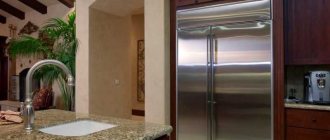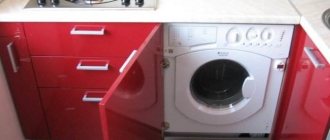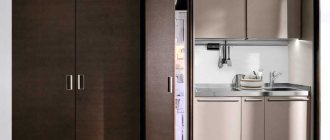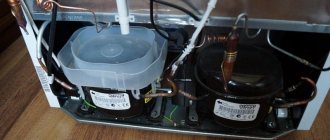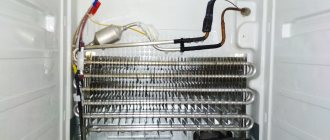Buying new modern household appliances is always a significant event for the whole family. But some items in the house require special attention when placing them. Few people think about what distance should be between the refrigerator and the wall, although both the durability of the appliance and its ability to fully perform its duties depend on this factor.
The service life of the refrigerator depends on the installation location and the distance between the appliance and the wall.
Features of the location of the refrigerator
Refrigeration equipment, if the kitchen area allows, is placed there. To the question: “Is it possible to place a home refrigerator close to the wall?”, experts answer in the negative. This object, creating cold inside, releases a large amount of heat into the surrounding space. When placed close to the wall, the latter does not go away, the device constantly overheats, does not freeze well and, ultimately, completely fails. An equally dangerous “neighborhood” is a stove, a heating radiator.
Experts strongly do not recommend installing the refrigerator close to the wall.
A refrigerator built into a cabinet is a very popular modern solution. But it is also necessary to leave space from the front door to the device itself: at least five to six cm on the sides, nine to ten on the top.
Advice. Specific recommendations for installing a particular device are described in detail in the technical data sheet attached to it.
Built-in refrigerator in kitchen design.
See alsoKitchen renovation, interior design and decoration
Correct installation of the refrigerator
To properly install an expensive device, it should be carefully delivered to the right place. Most modern models cannot be transported horizontally. The floor at the installation site must be level, but in most apartments and houses this is not the case, which is why refrigeration equipment is equipped with height-adjustable legs.
The refrigerator must be installed on a flat floor surface.
The most important points to consider when placing a refrigerator in the kitchen:
- acceptable temperature conditions;
- air humidity level;
- efficient cooling of the condenser;
- range of location of heating appliances, stoves, ovens;
- uniform support of the unit on all four legs;
- the likelihood of exposure to direct rays of the sun, heating under their influence.
Advice. Proper placement of the refrigerator will not only allow it to operate uninterruptedly for a long time, but will also significantly reduce energy consumption.
Under no circumstances should you install a refrigerator next to heating appliances.
See also: What mistakes should you avoid in designing and choosing the style of a winter garden?
Rules for installing a refrigerator in the kitchen
After you have unpacked and washed the device, questions arise: what to do next, how to connect the refrigerator? First you need to choose a suitable installation location. Even if the kitchen is small, you should not connect the device next to other appliances or furniture.
When the air in the refrigerator compartment is cooled, the compressor becomes very hot. The walls of the equipment require free air circulation. If the kitchen set or appliances interfere with this, the efficiency of the refrigerator will be significantly reduced.
Important! The distance between the refrigerator and other objects must be at least 5 cm. Many modern units have special stops that prevent them from being installed close to equipment or a wall.
It is not advisable to place the device next to an electric or gas stove, as well as radiators, as this will cause the refrigerator to overheat. If you still can’t put it in another place, install a barrier for protection, for example, made of plywood covered with foil.
Before installation, make sure that the equipment is located away from natural grounding conductors, as this will also affect the efficiency of the refrigerator. Or, as a last resort, they protect grounded devices with a wooden grid.
In a small kitchen, many people try to save space by integrating refrigeration equipment into the furniture. This can be done if there are gaps. There are refrigerators in which the fan and compressor are located at the bottom. Such devices can be placed close to the walls.
Installation conditions
When installing the device in the room, it should not be cold - at a temperature of less than +5 degrees it is generally dangerous to plug it into the network. Any distortions in the structure cause noise during operation of the equipment. To place the refrigerator as level as possible, you will need a building level, and if you want its door to close itself, the front legs are twisted a little more - this ensures a tilt of one or two degrees. If it turns out that the unit is slightly tilted forward, this needs to be corrected urgently - the seal between the cabinet itself and its door is broken. When the right or left corner of the structure is lower, a gradual skew of the door and a violation of the seal of the chamber cannot be avoided.
Under no circumstances should the device be turned on in a cold room after installation.
See alsoTips on choosing a design for a small kitchen of 5-6 meters in Khrushchev
Basic moments
Before purchasing a refrigerator, you should consider delivery issues - hire a vehicle of the appropriate size, measure the elevator doors, entrance and kitchen door openings so that the unit can be brought into the room without any problems. If you transport the device by placing it on the door or back wall, the compressor may come off and the freon may not flow properly, which can cause an air bubble to form and the system’s tightness may be compromised.
In winter, the distance of the device to the wall should be about 5 cm.
The most important installation rules:
- you need to place the refrigerator away from the sun and drafts, but where there is sufficient movement of air masses;
- in winter, the distance from the wall to the back wall of the unit is about five centimeters, in the summer it is moved back another three to five;
- the further the refrigerator is placed from any heating devices, the better, but it is not advisable to place it exactly opposite a gas, electric stove, heating radiator, etc.;
- Items such as a washing machine, any other electrical appliances (coffee maker, microwave oven, toaster, etc.) must not be installed in close proximity to the item;
- the refrigerating cabinet is placed at the same distance from various pieces of kitchen furniture;
- You should not connect the refrigerator through an extension cord or tee - it is permissible only through a stationary outlet.
Other household appliances are not allowed to be installed close to the refrigerator.
See also: Choosing the right tile design for the kitchen
Important rules for installing a refrigerator yourself
After purchasing a refrigerator, the equipment must be installed correctly. Study the recommended rules for placement in apartments and houses in order to know in advance where it is better to place a new unit and which refrigerator to take for your home - free-standing or built-in.
Floor - durable
Before installing indoors, carefully examine the floors - they must be strong enough and motionless. You cannot install a large-sized refrigerator on a coating that is soft (4-5 layers of linoleum) and springs freely - for example, on boards up to 3 cm thick, located with a large gap. Due to vibration, the motor will hum louder, especially at night, and will soon fail.
If the covering is plank and springy, protect the floor surface with plywood at least 4-5 mm thick.
It is better to install the equipment on concrete - such a floor will withstand even a two-door, two-chamber unit of maximum height. The coating can be finished in any way, but for large equipment a tiled base is more suitable.
Warmth - away
To install a freezer and refrigerator, consider areas of the room far from heat sources. If you do not follow this rule, the unit will quickly fail. The compressor operates constantly, because the device heats up, as a result, the air inside the chamber needs to be cooled regularly. If used for a long time in such conditions, the thermostat fails, and soon the engine fails.
When installing a refrigerator, you should consider the location of the window in the room.
For the same reason, refrigerators and freezers are not placed near windows - in the summer they heat up just like radiators and break down faster. The exception is cases when there is an air conditioner in the room.
It is also impossible to place such equipment next to a gas or electric stove - if the stove is used frequently, it generates a lot of heat.
Minimum distance from heat sources: from the radiator - 30 cm, from the stove - 50 cm.
Sockets - closer
Pay attention to the presence of sockets nearby. The best option is to have a power source near the device.
- Include a direct wire from the electrical panel into the project during the construction phase.
- Buy sockets with grounding (small antennae on the body).
- But even if there is no outlet nearby, do not use multiple extension cords. All the energy from them will accumulate on the first “tee” connected to the plug, the network will be overloaded - and this is a serious risk of fire.
Water is the enemy
Do not install the refrigerator near sinks, taps, washing machines and water pipes: even if they are not close together, splashes will still reach the refrigerator - and you will receive an electric shock from the body. The ideal distance from the water is 2-3 m.
How to move or relocate correctly
The refrigerator can be rolled around the kitchen using a pair of rear wheels. We tilt it back a little and pull the lower part towards us.
We do diagnostics on LG refrigerator#refrigeratorLGsmartdiagnostics#
Watch this video on YouTube
Avoid sharp tilts - the device can be dropped onto the floor with its radiator. After such a fall, not all units continue to work; repairs are often required.
Secure the power cord to the grille on the back of the device. If the wire drags along the floor, it is easy to break it, break it, or damage the insulation. For fixation, fasteners are used - plastic clamps.
Electricity and cables
To ensure safe operation of the device, connect it to the electrical panel via a circuit breaker (RCD). Ideally, allocate a separate outlet for the refrigerator. As a last resort, use an extension cord - but only one.
If you cannot connect the unit to a separate outlet, use a surge protector - it will ensure the safety of equipment of any brand (AEG, Beko, Electrolux, , Indesit, Samsung, Whirlpool, Bosch, etc.). If there is a voltage drop, the external fuse will burn instead of the delicate electronics.
Placement nuances
It is important to know that it is also impossible to place a refrigeration appliance close to a radiator, gas or electric stove, oven - any overheating from the outside will sooner or later lead to breakdown. The minimum permissible distance between them is 50-70 cm. The same applies to installation within reach of direct sunlight - the refrigerator will get very hot, especially in summer.
If the kitchen is very small and the temperature is high, then the refrigerator can be moved to the hallway for normal operation of the unit.
Installing a refrigerator in the kitchen speeds up the cooking process, but when the temperature here is constantly too high, the unit is placed in a spacious hallway, niche, or pantry. To ensure uninterrupted operation, the product is regularly cleaned of dust, the “coat” is monitored for freezing, and periodically defrosted.
See alsoOriginal kitchen design in green: useful tips on choosing finishes, furniture, curtains
How to install a refrigerator correctly: 5 important points
Most of the installation requirements for the refrigerator are described in the operating instructions, which you will find in the accompanying documentation package. Study it carefully, paying special attention to the compliance of the operating class with the actual conditions, ambient temperature and air humidity in the room.
To ensure that your home cold storage device lasts a long time and does not cause vagaries to annoy you during operation, you should consider a few simple rules when installing such equipment:
- unpack and clean the refrigerator
- choose the right location for the device
- level the refrigerator/freezer cabinet
- connect the ice maker to the water supply if necessary
- connect the device to the network
Unpacking and Preparing for Installation
Unpacking the box and removing the foam blocks protecting the case, base stand, film and stickers will not cause much difficulty. After this, do not forget to unscrew the shipping bolts that secure the compressor springs. People often forget to do this, and then try to find the source of the increased noise. Open the doors, check the integrity of the plastic trays, drawers and glass, and then remove all components and accompanying documents. To prepare the installation of the device for permanent residence, it should be thoroughly washed both inside and outside. Plastic, factory grease and other materials in new equipment may have a specific odor. Therefore, to remove it, use a soft sponge and a non-aggressive soap solution with a little vinegar added. You also need to wash the floors in the intended installation location.
Do not forget that after delivery the device must stand for 6 - 12 hours so that the freon and compressor oil, “disturbed” by the tilt and shaking of transportation, flow into place, and the microparticles of the resulting condensate completely evaporate. All this time, it is strictly forbidden to connect the device to the network, especially in winter, when a large temperature difference between the street and the house increases moisture condensation.
Classic refrigerators Full No Frost LG GA-B509CQWL from 38,500 rub. LG GA-B379SQUL from RUR 31,350 Bosch KGN39AI32R from 56,000 rub. Bosch KGN39VW25R from RUR 36,810 Gorenje NRK 6191 EW4 from RUR 25,720 POZIS RK FNF-172 from 24,470 rub. Indesit ITR 5200 W from 28,000 rub. Gorenje NRK 6191 ES4 from RUR 26,740 LG GA-B419SQGL from RUR 29,990 LG GA-B419SQJL from RUR 27,680 Stinol STN 167 from 19,000 rub. Gorenje NRK 6192 AC4 from RUR 33,627 LG GA-B379SLUL from RUR 37,590 Samsung RB30A32N0SA from RUR 32,987 LG GA-B419SYJL from RUR 28,500 Gorenje NRK 6202 AXL4 from RUR 37,580 Gorenje NRK 6201 PW4 from RUR 18,000 Bosch KGN39AW32R from RUR 54,000 Beko RCNK 270K20 W from RUR 23,800 Bosch KGN39VI25R from RUR 43,900
Choosing the right installation location
It would be strange if you didn’t “figure out” in advance where you could put the new thing. Although, these design plans can be seriously interfered with by the recommended requirements and basic common sense. Let's immediately exclude places where it is undesirable to place a refrigerator:
- Near the window.
Proximity to a window opening threatens increased humidity and direct sunlight on the surface, causing overheating of the device and fading of the housing coating. - For heating radiators, heaters, stoves and ovens.
Due to the proximity of heat sources, the compressor starts up more often, wears out faster and eventually fails. If it is impossible to avoid proximity to the heated surface of other devices, then it is necessary to ensure a minimum distance of at least 0.5 meters. Using a barrier made of thermal insulating material or covering the refrigerator with foil that reflects thermal radiation will also help to slightly reduce the temperature. But these tricks, one way or another, will affect the overall aesthetics of the kitchen interior. - Near the sink or sink.
As with any electrical appliance, placing the refrigerator adjacent to a water source can result in splashes on the body and socket, which can cause a short circuit. - On the balcony.
In the warm season, the humidity on an unglazed balcony is too high (more than 80%), and the covered area gets very hot in the sun, preventing normal operation. In the off-season, starting the compressor at temperatures above +5 °C will be difficult due to oil thickening in the cold.
From the point of view of convenient access, the refrigerator, regardless of the kitchen layout, should, together with the stove and sink, form a triangular workspace. In such a zone, these “three pillars” do not necessarily have to be nearby - it is enough to be within walking distance.
Thus, the best place for the refrigerator will not be the sunny side of the kitchen, where there will be an auxiliary table or cabinet between the appliance and the sink/stove.
For trouble-free operation of the refrigeration unit, good ventilation is also needed, which is ensured by the minimum allowable clearances:
- top about 100 mm
- to the wall (back and side) about 50 mm (preferably 70 - 100 mm)
Insufficient clearance for air circulation negatively affects heat removal from the condenser and compressor, which can lead to damage to the device. Under normal conditions, the temperature of these very heating elements is 10 - 15 °C higher than the room temperature, so it is very important that they are well ventilated. The refrigerant condenser is most often located on the back wall of the device and is a serpentine tube with wire fins. In many models of refrigerators with the Full No Frost system, the condenser is hidden behind the side walls of the appliance.
Another important point to consider is the proximity of a household outlet. The refrigerator's power cord has a limited length, and safe operation of the appliance does not allow it to be turned on through an extension cord.
Classic refrigerators without No Frost (drip)
Atlant XM-4208-000 from 14,770 rub. Atlant XM-6025-031 from 24,000 rub. Atlant XM-6023-031 from 22,000 rub. Atlant XM-6024-031 from 22,000 rub. Atlant MXM-2835-90 from 15,800 rub. Gorenje RK 4181 PS4 from RUR 18,950 Gorenje RK 4181 PW4 from RUR 18,000 Atlant XM-6021-031 from 21,500 rub. Stinol STS 185 from 18,000 rub. Atlant XM-6026-031 from RUR 25,500 Biryusa 118 from 14,200 rub. Bosch KGV39XW22R from RUR 26,710 Atlant X 1602-100 from RUR 22,780 Biryusa 120 from 15,330 rub. Biryusa 108 from 10,540 rub. Bosch KGV39XL22 from 28,000 rub. Atlant XM-4709-100 from 22,736 rub. Atlant XM-4625-101 from RUR 26,262 Atlant XM-4021-000 from 19,300 rub. Atlant X 1602-140 from RUR 22,941
Installing the refrigerator by level
At the next stage, the actual installation of the device is carried out at the selected location using a conventional construction bubble level. Using this simple tool, you should level the refrigerator horizontally and vertically, adjusting the height of the legs along the threads. Ideally, the floor under the device should be strong and level, and to prevent the device from moving during operation due to vibration, you can additionally use anti-slip stickers under the legs.
Advice.
In order for refrigerator doors without closers to close independently under their own weight, it is recommended to tilt the appliance backwards by 2 - 3 ° by adjusting the front legs.
Side-by-side refrigerators
Liebherr SBSesf 7212 from 80,500 rub. LG GC-B247JLDV from RUR 73,500 Liebherr SBS 7212 from RUR 104,000 LG GC-B247SMDC from 88,300 rub. Biryusa SBS587 I from 42,390 rub. LG GC-B247JEDV from RUR 72,400 LG GC-B247SEDC from RUR 83,490 Gorenje NRS 9181 MX from RUR 55,581 Hisense RS-560N4AD1 from RUR 40,750 MAUNFELD MFF177NFW from RUR 49,985 LG GC-B247SVDC from 79,000 rub. LG GC-Q247CBDC from RUR 115,490 Samsung RS54N3003EF from RUR 74,290 Samsung RS54N3003WW from RUR 65,750 Samsung RS62R5031B4 from 78,880 rub. LG GC-Q247CADC from RUR 118,000 Biryusa SBS587 BG from RUR 41,020 Samsung RS63R5571F8 from RUR 84,499 Bosch KAG93AI30R from RUR 128,000 LG GC-L247CBDC from RUR 114,000
Connecting a unit with an ice maker
Currently, expensive multi-compartment Side-by-side and French-door refrigerators are additionally equipped with such useful devices as an ice maker and a water dispenser. There are bulk structures that use their own reservoirs to prepare ice and cold water, and there are also stationary flow devices, the peculiarity of their functioning is that they need to be connected to a water supply. This is a simple job, similar to connecting a washing machine, which you can do yourself or with the help of a specialist.
Refrigerators with water dispenser
Bosch KAG93AI30R from RUR 128,000 LG GC-L247CBDC from RUR 114,000 Samsung RS64R5331B4 from RUR 114,490 Hitachi R-W662FU9X from RUR 71,990 HIBERG RF-47DD NFS from RUR 44,990 LG GR-X24FTKSB from RUR 202,995 LG GR-X24FMKBL from RUR 167,999 HIBERG RFS-484DX NFYm from RUR 62,911 Bosch KAI93VL30R from RUR 123,900 Ginzzu NFK-521 from 65,990 rub. Samsung RT62K7110SL from RUR 80,900 Novex NSSN117893W from RUR 46,999 Winia FRN-X22H5CWW from 69,710 rub. Winia FGK-51EFGW from RUR 41,549 HIBERG RF-23DS from RUR 24,823 HIBERG RFS-484DX NFY from RUR 59,990 HIBERG RF-47DD NFS+FR-34D NFS from RUR 101,509 Ascoli ADRFI375WD from RUR 44,249 HIBERG RFS-484DX NFXd from RUR 65,081 io mabe ORGS 2D FFFSS from RUR 185,000
Connecting the device to the network
To connect the refrigerator, it is recommended to use a two-pole socket with grounding. In newly built houses this is not a problem, but owners of apartments in old houses will have to come to terms with the lack of a grounding loop. This type of equipment does not like electrical networks with unstable parameters and is sensitive to power surges. Therefore, some modern models are equipped with built-in stabilizers, and if your device does not have one, then you need to purchase a voltage stabilizer for the refrigerator to preserve the “health” of the compressor.
Features of installing built-in refrigerators
Built-in refrigerators, which are no different in functionality from conventional free-standing models, have a different design and installation features. Since built-in appliances are placed in a furniture cabinet, they do not have an outer casing as such. Such models are especially demanding for good ventilation, because the small space of a closed niche can lead to an increase in the ambient temperature. Here it is also necessary to provide gaps between the furniture walls and the outer surface of the refrigerator to allow air flow to the unit from all sides. Typically, to improve airflow, a furniture cabinet is made without a back wall, and the tray is made with ventilation holes.
Air intake grilles at the base of the furniture cabinet and in the upper space above the refrigerator also serve the same purpose.
And the main difficulty that the installer will face is accurately attaching the facade panels to the refrigerator doors.
The fronts are made in the same design as all kitchen furniture and, after installation on the refrigerator doors, it looks like an ordinary cabinet.
Based on the method of fastening, there are two types of facade panels - rigid and sliding. When hard
When attaching a decorative panel to a door, they form a single whole, and the advantage of this type of installation is the ability to open the door at an angle of 110 - 115˚. There is absolutely no gap between the facade and the door, which makes this structure monolithic and solid. And as a disadvantage of this type of fastening, it is worth noting the increased load on the door hinges.
Sliding
The type of panel installation involves fastening the panel to a furniture cabinet using telescopic guides, which ensure simultaneous sliding movement of the front panel and door when opening. In this case, the load on the hinges is much less, but the reliability of the fastening very much depends on the quality of the guides.
Perhaps the installation of facades is the most labor-intensive part of installing built-in models, and therefore it is better not to do it yourself, but to use the services of professionals.
Built-in two-chamber refrigerators
Samsung BRB266000WW from RUR 57,700 Samsung BRB306054WW from RUR 84,990 Beko BCHA 2752 S from RUB 31,370. Gorenje RKI 4182 E1 from RUR 34,290 Whirlpool SP 40801 from RUR 77,000 Whirlpool SP 40802 from RUR 87,000 Liebherr ICNf 5103 from 63,000 rub. Atlant XM 4307 000 from 24 000 rub. Samsung BRB307154WW from RUR 79,500 Liebherr ICNSf 5103 from 70,000 rub. Midea MRI 9217 FN from RUR 39,700 Beko BCNA 275 E2S from 52,000 rub. LG GR-N266LLD from RUR 59,713 Liebherr SBS 33I3 from 118,000 rub. Hansa BK 316.3 FA from RUR 34,790 Whirlpool ART 9810 A+ from RUR 52,469 Smeg C 8194TNE from RUR 91,198 Hotpoint-Ariston BCB 70301 AA from RUR 34,690 Indesit BIN 18 A1 DIF from RUR 32,500 Bosch KIN 86VS20 from 66,000 rub.
In conclusion….
As you can see, there is nothing complicated about installing and connecting a regular refrigerator. The above rules and recommendations are quite simple to follow, but following them will have a positive effect on the efficiency of the machine, the prevention of operational failures and its long service life. Monitor for a few days after first turning on how the refrigerator works and how well it copes with its functions. Pay attention to the sound background that accompanies the operation of the unit, and if there is strong noise, look for its cause. If you have never heard an appliance equipped with a No Frost system in operation, then at first the gurgling sounds that the refrigerator makes will be new. These are completely natural background sounds that you will get used to over time. Don't worry if the back or side walls feel too warm to the touch. The permissible heating temperature of these surfaces up to 45 °C is the norm - this is how the condenser heat sink works. But, if the temperature is noticeably higher, then it’s time to sound the alarm and call a service technician.
Technical installation standards
Installing the refrigerator in an excessively hot or too cold place is unacceptable. Such a popular refrigerant as freon begins to thicken at temperatures tending to zero - in winter, such an item will not be able to work on an uninsulated balcony or unheated dacha.
The refrigerator must be connected directly to the outlet.
What else needs to be taken into account when installing and operating an electrical appliance:
- rational, convenient placement between other pieces of furniture;
- maximum close contact between the socket and plug;
- the thermoregulation system is adjusted in accordance with the time of year and the required temperature conditions;
- Do not allow the formation of a large “snow coat” on the evaporator.
Experts do not recommend installing a refrigerator on the balcony.
See alsoHow to express your individuality in an unusual kitchen design
Is it possible to put a refrigerator on the balcony
When there is no place for a refrigerator either in the kitchen, or in the hallway, or in the pantry, some people put it on the balcony. This is not the best solution if the area is not sufficiently insulated. But in a “warm” loggia or glazed balcony, the refrigerator faces another danger - overheating in the sun, especially when the windows face the hot south side.
The distance between the refrigerator and other kitchen appliances should be at least 2-3 cm.
See alsoNo Frost cooling technology: features, pros and cons of No Frost, care tips
Basic rules for installing a refrigerator
The rules apply to all models of refrigerators, regardless of the company and operating technology (No Frost or classic).
When purchasing any equipment, the kit includes accompanying documentation - instructions. And, before turning on the same refrigerator, you need to carefully read it.
Here are some basic requirements regarding the installation of refrigeration equipment:
- There should be no heat sources near the device (radiators, microwave ovens, stoves). They can cause an increase in the overall temperature, which will negatively affect the operation of the refrigerator;
- It’s good if the place is ventilated;
- The room temperature is important. Refrigerators have their own climate class - permissible operating temperatures. Some models can be used in hot conditions, others only in normal conditions. The refrigerant flowing in the “body” of the refrigerator is also important. For example, freon R134 will thicken if the ambient temperature is below 0. You cannot place such equipment on the balcony;
- The humidity level in the room should not exceed 80%. In turn, products of plant origin are perfectly preserved at a humidity of 95%, and products of animal origin - no more than 50%;
- The outlet to which the device is connected must be grounded. A refrigerator is a large household appliance that requires a lot of power, so a separate outlet is allocated for it;
- a gap of 7–10 cm is left between the refrigerator and the wall, which is necessary for ventilation of the rear wall of the equipment;
- Most refrigerator models are equipped with a stabilizer that prevents damage due to power surges. Therefore, the refrigerator must be connected to the outlet directly, without using extension cords or tees;
- It will be useful to adjust the legs if the equipment is standing on an uneven surface. This should not be neglected, as the load on the motor-compressor will increase.
Conflicting opinions regarding distance from the wall
For those who are interested in the approximate distance from the wall a refrigerator should be, refrigerator experts answer: at least 3-9 centimeters. Statistics show that the overall period of uninterrupted operation of the unit directly depends on this. During installation, it is taken into account whether the side walls are free. That is, for a free-standing appliance with nothing adjacent to the sides, three to four cm will be enough, if one wall is “occupied” - about five cm, but if the refrigerator is built into a niche or fit into the middle of the set - up to ten cm.
The service life directly depends on the correct installation of the refrigerator.
See alsoThe main types of refrigerators and their operating principles, tips and recommendations for choosing
Possible consequences of improper installation of the refrigerator
Noise is the most harmless sign of mistakes made. Rattling dishes in the refrigerator indicate that it would not hurt to achieve a more stable position for the equipment. If this is not done, other, more serious problems may appear over time, the most unpleasant of which is the noise made by the compressor.
Important! An engine that begins to rumble louder than usual is a sure sign of a breakdown. At first, this may only manifest itself as noise, but then problems with cooling arise (too high or low temperature, ice) or the refrigerator stops working altogether.
Also, rapid wear of the compressor is caused by close proximity to heat sources, lack of ventilation gaps, or incorrect selection of the operating mode. Also, improper installation of the refrigerator leads to rapid wear of the seals. As a result of this, problems with cooling first appear, and then the overheating motor begins to make noise.
Practical advice
The installation features also depend on the specific model of the device - overheating is most dangerous for “delicate” and “smart” imported equipment. The more powerful the refrigerator, the larger the recommended gap between it and other pieces of furniture. To prevent the product from deteriorating during operation, the serviceability of the electrical wiring is checked in advance, high-quality grounding is carried out, and stabilizers are installed that can prevent damage that inevitably occurs during sudden changes in voltage in the network.
Before installation, it is necessary to check the serviceability of the electrical wiring.
During transportation to its destination, the refrigerator should not shake excessively, which often happens when delivered from afar, on roads with many potholes. It is recommended to secure the product firmly and not remove it from the original packaging, where foam is placed in the right places. After unloading, but before connecting, the item should remain in the room for six to eight hours.
The back of the refrigerator should never touch the wall.
See also: Dining tables with marble tops: rules of use and care, useful recommendations
